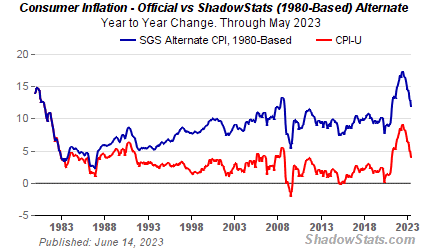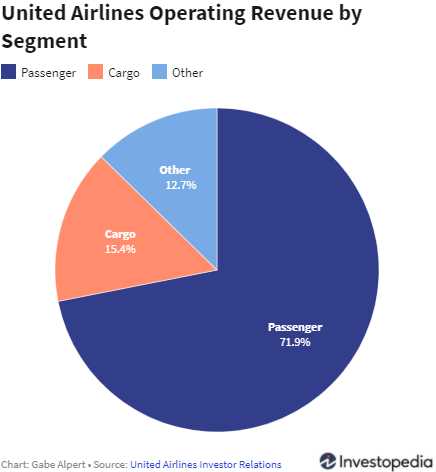 Inflation is everywhere.
Inflation is everywhere.
Coca-Cola (KO), Proctor and Gamble (PG) and others have discussed raising prices in response to rising input costs for their products including both labor and materials and that's the kind of permanent, long-term inflation that the Fed simply cannot ignore. "Transitory" inflation has been the Fed's excuse for extending their easy-money policy because the Fed's own mandate REQUIRES them to take action to curb inflation but major corporations announcing price increases is not at all transitory – it's embedded, long-term inflation.
As you can see from the ShadowStats chart above, the Fed mainly controls inflation by chaning the way we measure inflation – something they have done since they started messing with the CPI in the Reagan years in order to pretend giving money to rich people wasn't making poor people suffer. That's why, for the last few years – even though you CLEARLY could tell the price of things you buy were going up, the Fed kept saying inlfation was low and they had to let rich people borrow money at 0% to help boost it.
 When we apply a consistent measure of inflation for the last 15 years, our current rate of inflation is actually 10%, which makes perfect sense since the current devaluation of the Dollar over the last 12 months is also 10%. That's why KO and PG HAVE to raise prices, they buy commodities and turn them into products and a lot of what they buy comes from overseas, where the weak Dollar doesn't buy them as much as it used to. Both companies have indicated the price increses are earnings-neutral, so there won't be any better profits from this move – just higher prices passed along to the consumers.
When we apply a consistent measure of inflation for the last 15 years, our current rate of inflation is actually 10%, which makes perfect sense since the current devaluation of the Dollar over the last 12 months is also 10%. That's why KO and PG HAVE to raise prices, they buy commodities and turn them into products and a lot of what they buy comes from overseas, where the weak Dollar doesn't buy them as much as it used to. Both companies have indicated the price increses are earnings-neutral, so there won't be any better profits from this move – just higher prices passed along to the consumers.
Netflix (NFLX) is a company that has not been able to pass along higher prices because people don't NEED it and there's now a lot of competition. This is something I predicted would happen to them way back in April as a result of the pandemic:
That then brings us to the question of what stocks are really worth in a World where no one goes shopping or leaves their homes? While we all HOPE this will be over soon – what if it's not? I had a fun theory in yesterday's Live Trading Webinar that Netflix (NFLX) may have a broken model as they expect you to watch maybe 4 hours a day of shows and, by the time you watch 1,460 hours worth of content (1 year), they'll have some new content for you to keep you interested.
But what happens to NFLX if you watch 16 hours of shows a day for 90 days? That's 1,440 hours right there and now, in months 4-12, you find yourself looking at NFLX and saying "I've seen it all". Not literally ALL of their content but all the content that YOU are even mildly interested in and, by then, you have checked and the rest of the shows clearly do suck and you can't believe your Mom even likes the one she said you "must watch" – what is wrong with her?
Anyway, Netflix's subscription model assumes there's always going to be something to keep you interest but there are no shows in production and no films being released and people are chewing through content at a ridiculous pace. I think that makes it very, very hard to justify NFLX's current $185Bn valuation at $421 as they only made $2Bn last year and $700M last quarter in which they added 16M subscribers but, rather than be all excited about the additions – how about we consider that during a global pandemic in which 4Bn people can't leave their homes, ONLY 16M of them were finally pushed to sign up for NFLX.
Even if we assume NFLX makes $3Bn this year (up 50%) and $5Bn next year as we remain shut in forever and they never run out of content, etc… That's still pricing them at 37 times ridiculously optimistic forward earnings. I think the run above $400 is ridiculous so for our Short-Term Portfolio, let's make the following play:
- Buy 5 NFLX June $480 puts for $72 ($36,000)
- Sell 5 NFLX June $420 puts for $33 ($16,500)
- Sell 1 Sept $450 calls for $40 ($4,000)
That's net $15,500 on the $30,000 spread so our break-even is right about $450 and anything below that will be profit. The ordinary margin on the short call is just $3,737 so the market hasn't totally lost it's mind but we should set a stop on those short calls at $6,000, which would be over $450 as it wouldn't be worth the risk and then we'd have a net $21,500 cost on the $30 spread that we'd either adjust or give up on.
So a bit risky but fun to play!
NFLX expired on June 19th at $453.72 so the short calls were $3.72 ($372) and the spread was $26.28 ($13,140) in the money for net $12,768 so we would have lost net $2,732 had we held on but we did hit our $400 target in May and exited early. The up and down action was scary though so we didn't short them again, which is a shame because it just took longer than expected for people to get bored with Netflix. At $550 yesterday, we certainly should have shorted them into earnings and the stock dropped 10% overnight. Net profit for 2020 was only $2.7Bn – 10% LESS than I predicted but even if they make $6Bn going forward – how does that justify a $220Bn valuation at $500? That's 36.66 times OPTIMISTIC forward earnings. I stand by my $400 target – we'll just have to be patient.
 Another huge earnings miss was United Airlines, who lost $7.50 per $50 share in Q1 and that's a $2.4Bn loss on $3.2Bn in revenues with Passenger Revenues down 67.2% from Q1 2020, which was itself a curtailed quarter. Passenger Revenues are 72% of Operations so there's simply no getting around a disaster like that, is there? Cargo Revenue sure tried to make it up with an 88.3% gain from last year but that only took it to $497M – not enough to make a dent in the losses.
Another huge earnings miss was United Airlines, who lost $7.50 per $50 share in Q1 and that's a $2.4Bn loss on $3.2Bn in revenues with Passenger Revenues down 67.2% from Q1 2020, which was itself a curtailed quarter. Passenger Revenues are 72% of Operations so there's simply no getting around a disaster like that, is there? Cargo Revenue sure tried to make it up with an 88.3% gain from last year but that only took it to $497M – not enough to make a dent in the losses.
UAL forecasts Q2 to still be down 45% and the company is looking to cut $2Bn in Structural Costs to stop the bleeding but that's $2Bn less revenue for their vendors – so the economic suffering simply trickles down. They do expect to get back to "normal" eventually and currently valued at $16.2Bn would almost be interesting as they can earn $2Bn in a good year – but that year won't be until 2023 at best and I try not to invest $16.2Bn into a company that's losing $2.4Bn a quarter – even if they promise to cut $2Bn in spending in 90 days – show me first!
These are the earnigns stories we're getting and, hopefully, they'll give us a little insight into what we should invest in going forward. Certainly it won't be airlines for now….



